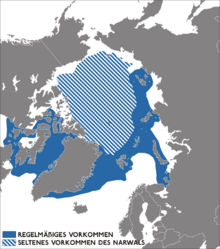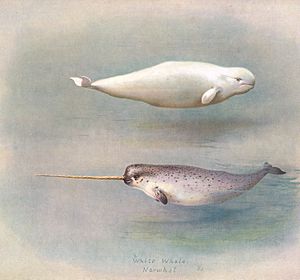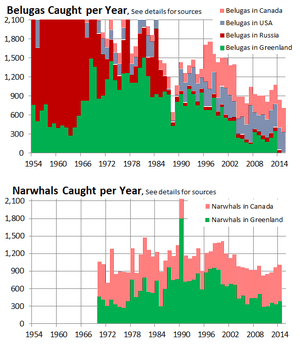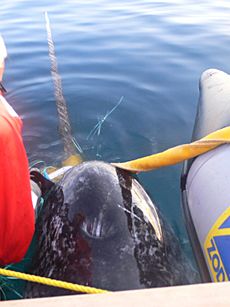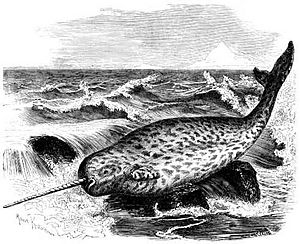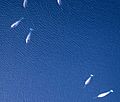Narwhal facts for kids
Quick facts for kids Narwhal |
|
|---|---|
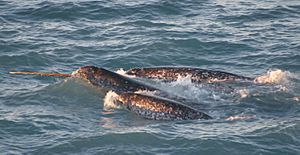 |
|
 |
|
| Size comparison with a human | |
| Scientific classification | |
| Kingdom: | |
| Phylum: | |
| Class: | |
| Order: | |
| Suborder: |
Olphinesa
|
| Family: |
Monodontidae
|
| Genus: |
Monodon
|
| Binomial name | |
| Monodon monoceros Linnaeus, 1758
|
|
The narwhal (Monodon monoceros) is a special type of whale that lives in the cold Arctic waters. People often call it the "unicorn of the sea." This is because male narwhals have a very long, spiraling tusk. This tusk is actually a super-long tooth! The name "narwhal" comes from an old language called Old Norse, and it means "corpse whale."
Contents
About Narwhals
Male narwhals can grow quite large. They can be up to 15 feet (4.5 meters) long and weigh as much as two tons. Female narwhals are a bit smaller.
When a baby narwhal is born, it's already about five feet (1.5 meters) long. It weighs around 180 pounds (82 kg). A female narwhal usually gives birth once every three years. Her pregnancy lasts about 15 months.
The Amazing Tusk
All narwhals have two teeth in their upper jaw. For male narwhals, the left tooth starts to grow outwards after their first year. It grows in a spiral shape. This amazing tusk can reach up to 8.75 feet (2.7 meters) long! It's usually twisted in a counterclockwise direction and is hollow inside.
Sometimes, a narwhal might even have two tusks, but this is very rare. For a long time, people wondered what the tusk was for. Scientists now think it might help narwhals sense things in the water. It could also be used for showing off or for communication. The tusk is not used for hunting food.
Long ago, when people found a narwhal tusk washed ashore, they often thought it was the horn of a unicorn. This might be how some of the old unicorn stories began!
Deep Divers
Narwhals are incredible divers. They can dive very deep into the ocean, sometimes as far as 1,500 meters (about 4,900 feet). This makes them one of the deepest-diving mammals in the sea! They can hold their breath for a long time during these deep dives.
Where Narwhals Live
Narwhals live in the very cold, icy waters of the Arctic seas. Their thick skin, called blubber, helps them stay warm. They like to stay close to ice.
Narwhals usually live in groups. These groups can have anywhere from 10 to 100 whales. They are also migrating animals. This means they move from one place to another depending on the season.
In the summer, many groups of narwhals come together. They move closer to land, where they can be seen in bays and fjords. You might spot them near Greenland, Northern Canada, and even eastern Russia. In the winter, they move back to the icy waters. They breathe through small holes in the ice.
What Narwhals Eat
Narwhals are good at hunting under the ice. They love to eat Arctic fish like Greenland halibut, polar cod, and Arctic cod. They also eat shrimp and squid. Narwhals don't have strong teeth for chewing. Instead, they suck their prey into their mouths with a lot of force.
Narwhal Behavior
Narwhals usually form smaller groups of about five to ten whales. Sometimes, these groups can be all females and young, or all young males, or all adult males. But mixed groups can happen too. In the summer, many of these smaller groups join up. They form huge groups that can have hundreds or even over a thousand whales!
Sometimes, male narwhals will gently rub their tusks together. This is called "tusking." It might be a way for them to show who is in charge. It could also be a way for them to share information about the water around them.
Communication
Like most whales with teeth, narwhals use sounds to find their way around and hunt for food. They make "clicks," "whistles," and "knocks." These sounds help them locate prey and avoid obstacles.
Reproduction and Life Cycle
Female narwhals usually start having babies when they are six to eight years old. Adult narwhals mate in April or May. The baby narwhal is born about 14 months later, usually between June and August.
Only one baby is born at a time. Newborn calves are about 1.6 meters (5.2 feet) long and are light grey or white. They drink their mother's milk, which is full of fat. This helps them grow a thick layer of blubber to stay warm. Calves stay with their mothers and drink milk for about 20 months. This long time helps them learn important skills to survive.
Life Span and Dangers
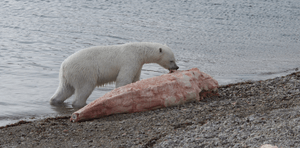
Narwhals can live for at least 50 years. However, they face some dangers. One big danger is getting trapped under the ice. If the Arctic waters freeze over too quickly in the late autumn, narwhals can't reach open water to breathe. If the ice is too thick to break through, they can drown.
Predators
Narwhals have natural predators. Polar bears sometimes attack young narwhals at breathing holes in the ice. Greenland sharks and walruses also hunt them. Killer whales, also known as orcas, are very dangerous. They can work together to trap and hunt groups of narwhals in shallow bays. To escape, narwhals might hide under large pieces of ice.
Human Hunting
Humans also hunt narwhals. The native Inuit people are allowed to hunt these whales. They use almost all parts of the narwhal, including the meat, skin, blubber, and organs. A special food called Muktuk is made from the raw skin and blubber. It's an important source of vitamin C.
In some places, Inuit hunters use traditional methods, like harpooning whales from handmade kayaks. In other areas, they use modern boats and rifles. About 1,000 narwhals are hunted each year, mostly in Canada and Greenland.
Protecting Narwhals
Narwhals are one of many animals that are facing threats from human actions. They are not yet an endangered species, but their future is uncertain. The biggest threat is climate change. As the Arctic ice melts, narwhals lose their natural habitat.
Scientists estimate there are about 80,000 narwhals left. Many groups are working to protect them. It's very hard to keep narwhals alive in aquariums, so conservation efforts focus on protecting them in their natural home. Some countries, like the European Union and the United States, do not allow narwhal tusks to be imported.
Narwhals in Stories and Art
In Legends
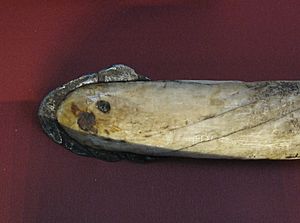
In Inuit legends, the narwhal's tusk was created in a magical way. A woman was dragged into the ocean by a harpooned narwhal. She turned into a narwhal herself, and her twisted hair became the spiraling tusk.
During the Middle Ages in Europe, many people believed narwhal tusks were horns from the mythical unicorn. They thought these "unicorn horns" had magic powers. People believed they could stop poisons and cure sadness. Vikings and other traders sold these tusks for huge amounts of gold.
Cups made from narwhal tusks were thought to protect against poison. In 1555, a drawing of a fish-like creature with a horn was published. It correctly identified the animal as a "Narwal." Later, in the 16th century, Queen Elizabeth I received a narwhal tusk that was worth as much as a castle!
In Books and Art
The narwhal was one of the ideas for the giant sea creature in Jules Verne's famous 1870 novel, Twenty Thousand Leagues Under the Sea. In the book, the "unicorn of the sea" was described as being 60 feet (18 meters) long!
Herman Melville also wrote about the narwhal in his 1851 novel Moby-Dick. He mentioned that a narwhal tusk hung in Windsor Castle for a long time. He also claimed that Danish kings made their thrones from narwhal tusks.
Images for kids
-
Narwhals in the Creswell Bay at Somerset Island
-
The head of an Inuit lance made from a narwhal tusk with a meteorite iron blade (British Museum)
See also
 In Spanish: Narval para niños
In Spanish: Narval para niños


